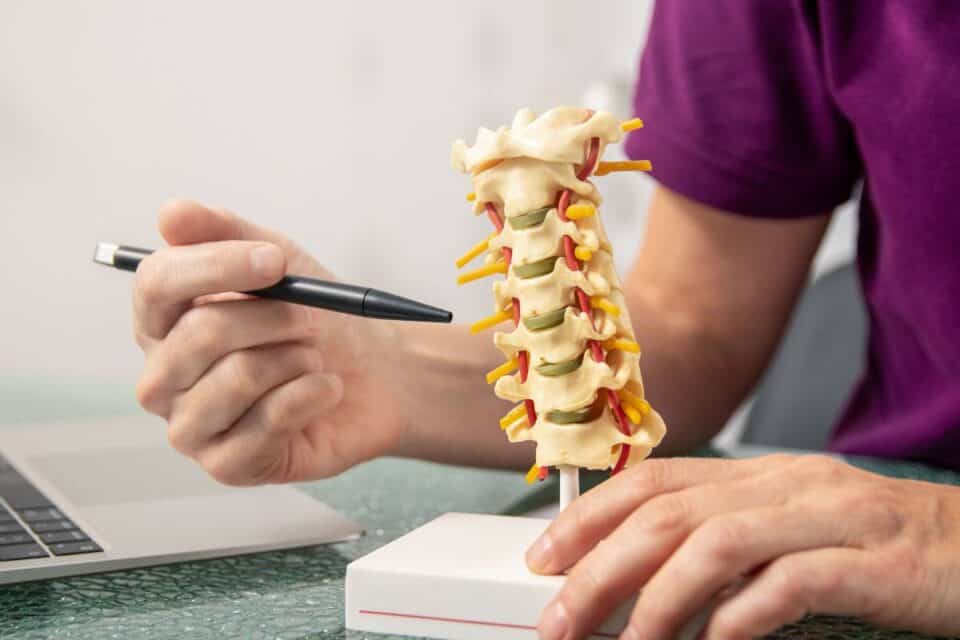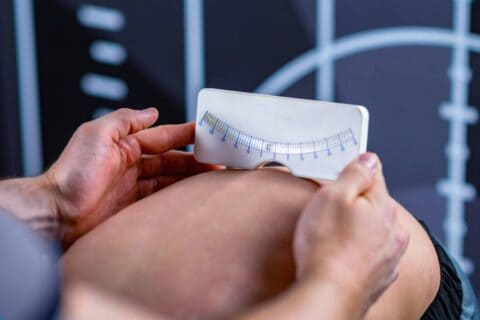I’ve seen firsthand how debilitating chronic back pain can be. At least 80% of the population will experience LBP sometime in their lifetime and I bet if you are reading this you are one of them. It’s a common problem that affects people from all walks of life, and it can have a significant impact on daily activities and overall quality of life. Fortunately, there are effective non-surgical treatment options available, and one of the most promising is non-surgical spinal decompression therapy.
Key Takeaways
- Non-surgical spinal decompression is an effective, non-invasive treatment for chronic back pain and related conditions.
- This therapy gently stretches the spine, reducing pressure on spinal discs and promoting natural healing.
- Spinal decompression can help patients avoid surgery, manage pain, and improve their overall quality of life.
Table of Contents
- Understanding Non-Surgical Spinal Decompression
- Conditions Treated by Non-Surgical Spinal Decompression
- The Non-Surgical Spinal Decompression Treatment Process
- Benefits of Non-Surgical Spinal Decompression
- Combining Non-Surgical Spinal Decompression with Other Therapies
- Candidates for Non-Surgical Spinal Decompression
- Preparing for Non-Surgical Spinal Decompression Treatment
- Post-Treatment Care and Maintenance
- Risks, Side Effects, and Contraindications
- FAQs
- Conclusion
Understanding Non-Surgical Spinal Decompression
Non-surgical spinal decompression is a logical answer to spine pain that uses specialized equipment to stretch the spine gently. By creating negative pressure within the spinal discs, this treatment helps to:
- Potentially reduce pressure on the nerves and spinal cord
- Promote the flow of nutrients and oxygen to the discs
- Encourage the retraction of herniated or bulging discs
Unlike surgical spinal decompression, which involves invasive procedures and lengthy recovery times, non-surgical spinal decompression is a safe and effective alternative that can provide lasting relief without the risks associated with surgery.
The evidence supporting the effectiveness of non-surgical spinal decompression is compelling. In a recent journal article in Orthopedic Technology Review titled “Surgical Alternatives: Spinal Decompression1,” results showed that 86% of the 219 patients who completed the therapy reported resolution of symptoms, while 84% of patients remained pain-free 90 days post-treatment.
Furthermore, another article in the Journal of Neurological Research2 reported that vertebral axial [spinal] decompression was successful in 71% of the 778 cases. The success rate varied from 73% for patients with a single herniated disc to 72% for people with multiple herniated discs.
Is SpineMed Your Path to a Pain-Free Life?
Tired of living with back pain? Take our quick quiz to see if you’re a candidate for the breakthrough SpineMed Treatment. It only takes a few minutes to potentially change your life.
Conditions Treated by Non-Surgical Spinal Decompression
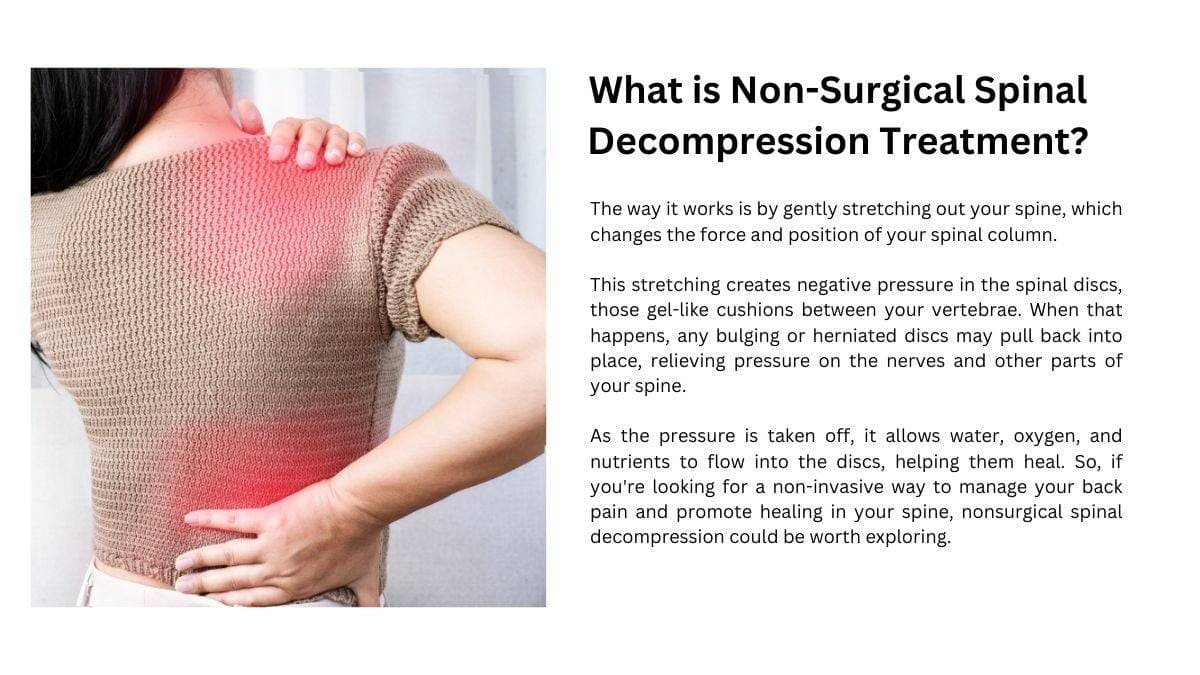
Non-surgical spinal decompression can be an excellent treatment option for a wide range of spinal conditions, including:
- Herniated or bulging discs: When the soft, gel-like center of a spinal disc pushes through a tear in the outer layer, it can put pressure on nearby nerves, causing pain and other symptoms.
- Degenerative disc disease: As we age, our spinal discs can begin to deteriorate, leading to pain, stiffness, and reduced mobility.
- Spinal stenosis: This condition occurs when the spaces within the spine narrow, putting pressure on the nerves and causing pain, numbness, and weakness.
- Sciatica and radiculopathy: When the sciatic nerve or other spinal nerve roots become compressed or irritated, it can cause pain, tingling, and numbness that radiates down the legs or arms.
- Facet joint syndrome: Inflammation or injury to the facet joints, which connect the vertebrae in the spine, can cause localized pain and stiffness. Chiropractic adjustments directly help increase the range of motion within these segments.
The Non-Surgical Spinal Decompression Treatment Process
If you’re considering non-surgical spinal decompression, the first step is to schedule a consultation with a qualified healthcare provider. During this initial evaluation, your provider will:
- Review your medical history and current symptoms
- Perform a concise physical examination
- Order imaging tests, such as X-rays or MRI scans, if necessary
- Develop a personalized treatment plan tailored to your specific needs
During a typical spinal decompression treatment session, you’ll lie comfortably on a specialized decompression table. The table is equipped with advanced technology that allows your provider to customize the amount of decompression applied to your spine. Our SpineMed table has sessions that last 30 minutes, and you may require a series of treatments to achieve optimal results.
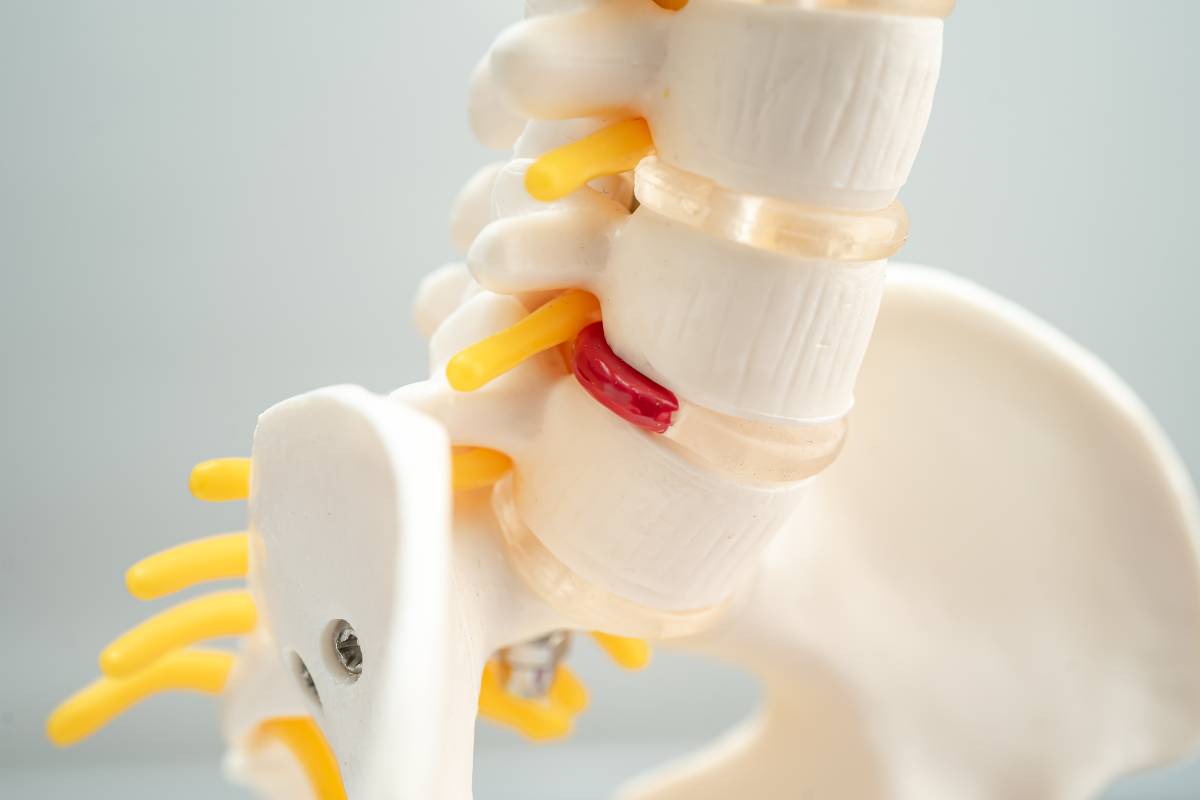
Benefits of Non-Surgical Spinal Decompression
The biggest benefit is that it treats the root cause! One of the most significant advantages of non-surgical spinal decompression is its ability to provide effective pain relief without the need for invasive procedures or powerful medications. By reducing pressure on the spinal discs and nerves, this therapy can help alleviate chronic pain, improve mobility, and enhance overall spinal health.
Other benefits of non-surgical spinal decompression include:
- Reduced inflammation: By promoting circulation and the flow of nutrients to the affected area, spinal decompression can help to reduce inflammation and promote healing.
- Improved spinal disc health: Decompression therapy can help to rehydrate and nourish the spinal discs, potentially slowing or reversing the effects of degenerative disc disease.
- Enhanced mobility and flexibility: As pressure on the spinal nerves is reduced, patients often experience improved range of motion and increased flexibility. Remember muscles can get tight from protecting pinched nerves. That’s why muscle spasms happen in the neck or lower back.
- Faster recovery time: Compared to surgical options, non-surgical spinal decompression typically involves a shorter recovery period and fewer complications. You can get back to work in a timely fashion and not expose yourself to loss of income.
Combining Non-Surgical Spinal Decompression with Other Therapies
While non-surgical spinal decompression can be highly effective on its own, many patients experience even better results when it’s combined with our other complementary therapies. Some of the most common adjunctive treatments include:
- Rehab program/videos: Targeted mobility and strengthening exercises can help support the spine, improve posture, and prevent future injuries.
- Chiropractic care and spinal manipulation: Gentle chiropractic adjustments can help to restore proper alignment, reduce pain, and enhance the effectiveness of spinal decompression therapy by taking pressure off the facet joints which are on the backside of the vertebrae.
- Summus Class IV Laser: Our laser can reduce pain by modulating inflammation, promote relaxation, decrease tissue decay, and support the body’s natural healing processes.
- Lifestyle modifications and ergonomics: Simple changes, such as maintaining good posture, using proper lifting techniques, and creating an ergonomic workspace, can help to reduce stress on the spine and prevent future episodes of back pain.
Candidates for Non-Surgical Spinal Decompression
While non-surgical spinal decompression can be an excellent treatment option for many patients with chronic back pain, it’s not appropriate for everyone. The ideal candidate for this therapy is someone who:
- Has chronic back pain or a related spinal condition that hasn’t responded to conservative treatments like medication or physical therapy
- Does not have any contraindications, such as spinal fractures, severe osteoporosis, or certain grades of spinal instability
- Is committed to following their provider’s recommendations and participating actively in their own recovery (very critical)
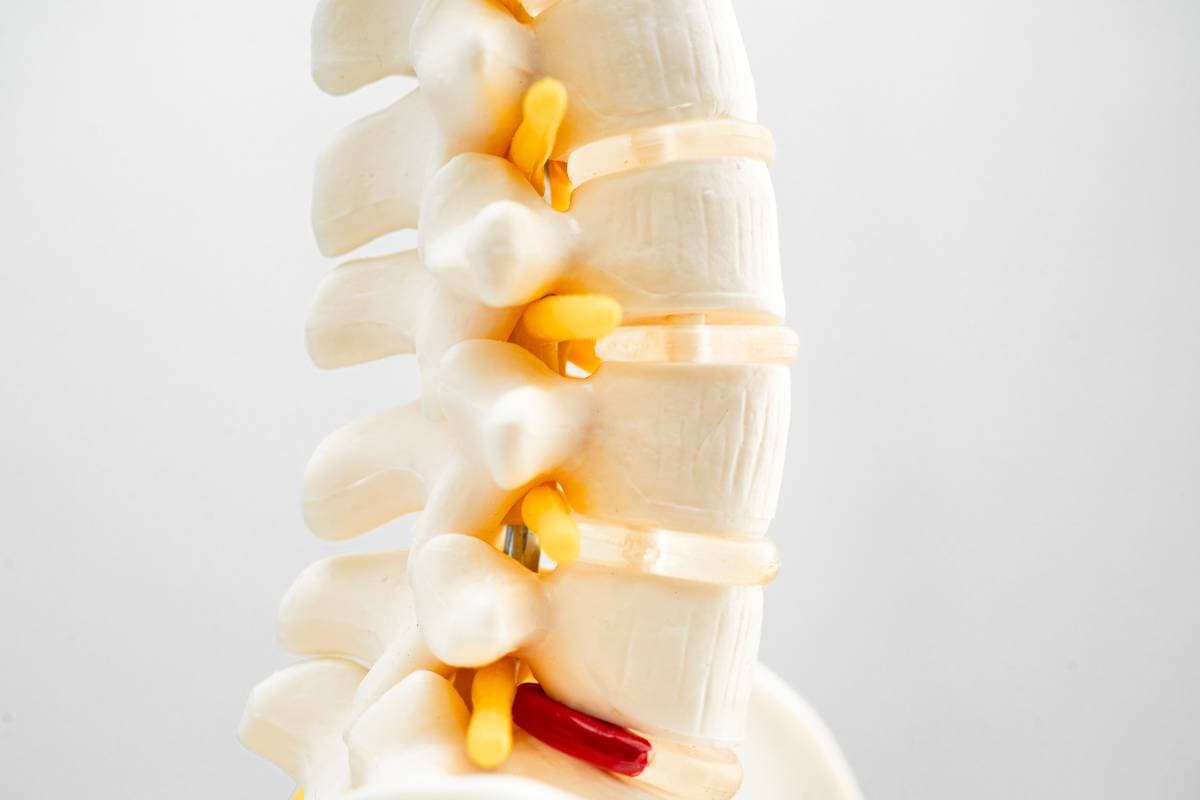
Preparing for Non-Surgical Spinal Decompression Treatment
If you and your healthcare provider have determined that non-surgical spinal decompression is right for you, there are a few simple steps you can take to prepare for your treatment sessions:
- Wear comfortable, loose-fitting clothing that allows for easy movement
- Stay hydrated by drinking plenty of water/electrolytes before and after your sessions
- Avoid eating a heavy meal within two hours of your treatment
- Inform your provider of any changes in your symptoms or medical history
Post-Treatment Care and Maintenance
To maximize the benefits of non-surgical spinal decompression and maintain your results over time, it’s essential to follow your provider’s recommendations for post-treatment care and maintenance. This may include:
- Continuing with a prescribed exercise program to strengthen the muscles that support your spine
- Attending follow-up appointments to monitor your progress and make any necessary adjustments to your treatment plan
- Practicing good posture and body mechanics to reduce stress on your spine
- Making lifestyle changes, such as maintaining a healthy weight, quitting smoking, and managing stress
Risks, Side Effects, and Contraindications
While non-surgical spinal decompression is generally considered a safe and well-tolerated treatment, there are some potential risks and side effects to be aware of. These may include:
- Temporary muscle soreness or stiffness
- Mild discomfort during the treatment session
- In very rare cases, a worsening of symptoms or the development of new symptoms
It’s important to note that non-surgical spinal decompression is not appropriate for everyone. Contraindications for this therapy may include:
- Spinal fractures
- Severe osteoporosis
- Certain types of spinal instability
- Pregnant women
- Patients with certain medical conditions, such as aortic aneurysms or advanced metastatic cancer
Is SpineMed Your Path to a Pain-Free Life?
Tired of living with back pain? Take our quick quiz to see if you’re a candidate for the breakthrough SpineMed Treatment. It only takes a few minutes to potentially change your life.
FAQs
How long does a typical non-surgical spinal decompression treatment session last?
Is non-surgical spinal decompression painful?
How many treatment sessions are usually required to achieve optimal results?
Can non-surgical spinal decompression be used in conjunction with other therapies?
Is non-surgical spinal decompression covered by insurance?
Is SpineMed Your Path to a Pain-Free Life?
Tired of living with back pain? Take our quick quiz to see if you’re a candidate for the breakthrough SpineMed Treatment. It only takes a few minutes to potentially change your life.
Conclusion
Non-surgical spinal decompression is a safe, effective, and non-invasive treatment option for individuals suffering from chronic back pain and related spinal conditions. By gently stretching the spine and reducing pressure on the spinal discs and nerves, this therapy can help alleviate pain, improve mobility, and promote natural healing without the risks and lengthy recovery times associated with surgery. Just simply ask yourself, Is it logical to decompress something when it’s compressed?
If you’re struggling with chronic back pain and are looking for a solution that doesn’t involve invasive procedures or powerful medications, I encourage you to explore non-surgical spinal decompression therapy.
As an experienced chiropractor, I’m committed to helping my patients achieve optimal spinal health and improved quality of life through personalized treatment plans that combine the latest techniques and technologies with a compassionate, patient-centric approach. Schedule a consultation and take the first step toward a pain-free, more active lifestyle.
Blog Disclaimer: The information provided on The BodyFix Chiro blog is for general informational and educational purposes only and is not intended as medical advice. These articles reflect our opinions and experiences but should not be used to diagnose or treat any health conditions. Always consult with your physician, chiropractor, or other qualified healthcare provider before starting any new treatment, exercise program, or making changes to your health routine. Any actions you take based on information from this blog are entirely at your own risk, and The BodyFix Chiro and its contributors disclaim any liability for the decisions you make based on this information.

